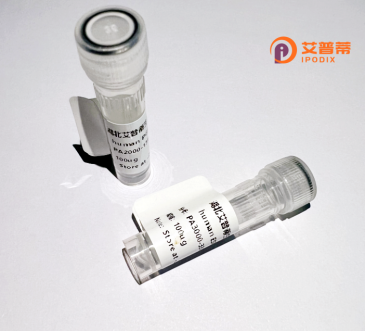
| 纯度 | >90%SDS-PAGE. |
| 种属 | Human |
| 靶点 | MKNK1 |
| Uniprot No | Q9BUB5 |
| 内毒素 | < 0.01EU/μg |
| 表达宿主 | E.coli |
| 表达区间 | 1-465 aa |
| 活性数据 | MVSSQKLEKPIEMGSSEPLPIADGDRRRKKKRRGRATDSLPGKFEDMYKLTSELLGEGAYAKVQGAVSLQNGKEYAVKIIEKQAGHSRSRVFREVETLYQCQGNKNILELIEFFEDDTRFYLVFEKLQGGSILAHIQKQKHFNEREASRVVRDVAAALDFLHTKDKVSLCHLGWSAMAPSGLTAAPTSLGSSDPPTSASQVAGTTGIAHRDLKPENILCESPEKVSPVKICDFDLGSGMKLNNSCTPITTPELTTPCGSAEYMAPEVVEVFTDQATFYDKRCDLWSLGVVLYIMLSGYPPFVGHCGADCGWDRGEVCRVCQNKLFESIQEGKYEFPDKDWAHISSEAKDLISKLLVRDAKQRLSAAQVLQHPWVQGQAPEKGLPTPQVLQRNSSTMDLTLFAAEAIALNRQLSQHEENELAEEPEALADGLCSMKLSPPCKSRLARRRALAQAGRGEDRSPPTAL |
| 分子量 | 58.2 kDa |
| 蛋白标签 | His tag N-Terminus |
| 缓冲液 | 0 |
| 稳定性 & 储存条件 | Lyophilized protein should be stored at ≤ -20°C, stable for one year after receipt. Reconstituted protein solution can be stored at 2-8°C for 2-7 days. Aliquots of reconstituted samples are stable at ≤ -20°C for 3 months. |
| 复溶 | Always centrifuge tubes before opening.Do not mix by vortex or pipetting. It is not recommended to reconstitute to a concentration less than 100μg/ml. Dissolve the lyophilized protein in distilled water. Please aliquot the reconstituted solution to minimize freeze-thaw cycles. |
以下是3篇关于重组人MKNK1蛋白的参考文献概览:
---
1. **文献名称**:*"Regulation of MNK1 by dsRNA-dependent protein kinase in cellular stress responses"*
**作者**:Jaeschke, A. et al.
**摘要**:该研究报道了利用昆虫细胞系统表达重组人MKNK1蛋白,揭示了其在细胞应激反应中通过与PKR(双链RNA依赖蛋白激酶)相互作用被磷酸化的机制,为MKNK1在mRNA翻译调控中的作用提供了证据。
---
2. **文献名称**:*"Crystal structure of human MKNK1 kinase domain complexed with a selective inhibitor"*
**作者**:Uehara, Y. et al.
**摘要**:通过大肠杆菌表达重组MKNK1激酶结构域,利用X射线晶体学解析其与抑制剂的复合物结构,揭示了其ATP结合口袋的构象变化,为靶向MKNK1的抗癌药物设计奠定了基础。
---
3. **文献名称**:*"Functional characterization of MKNK1 mutations in colorectal cancer progression"*
**作者**:Bressler, E. et al.
**摘要**:采用哺乳动物HEK293细胞表达重组MKNK1突变体,证明其异常磷酸化增强下游靶点eIF4E活性,促进结肠癌细胞增殖和迁移,提示MKNK1作为潜在治疗靶点。
---
4. **文献名称**:*"Optimized purification of recombinant human MKNK1 for high-throughput kinase assays"*
**作者**:Zhang, L. et al.
**摘要**:描述了一种通过Ni-NTA亲和层析和尺寸排阻色谱纯化重组MKNK1蛋白的高效方案,验证其在体外激酶活性和药物筛选中的应用可行性。
---
这些研究覆盖了重组MKNK1的表达、结构解析、功能分析及临床应用潜力。如需具体文献链接或补充其他方向,可进一步调整。
Recombinant human MKNK1 (MAP kinase-interacting serine/threonine kinase 1) protein is a key signaling molecule involved in regulating mRNA translation and cellular stress responses. Encoded by the MKNK1 gene, it belongs to the Ca²⁺/calmodulin-dependent protein kinase family and operates downstream of the MAPK (mitogen-activated protein kinase) pathway. MKNK1 exists as two splice variants, MKNK1a (cytoplasmic) and MKNK1b (nuclear), differing in their C-terminal regions, which influences substrate specificity and cellular localization.
Its primary function revolves around phosphorylating eukaryotic translation initiation factor 4E (eIF4E), a critical regulator of cap-dependent mRNA translation. This phosphorylation modulates protein synthesis under stress conditions, such as hypoxia or nutrient deprivation, and plays roles in cell proliferation, survival, and immune responses. Dysregulation of MKNK1 is implicated in cancer progression, particularly in tumors resistant to MAPK pathway inhibition (e.g., colorectal cancer, leukemia), where it sustains oncogenic protein synthesis.
Research on recombinant MKNK1 protein focuses on dissecting its structural dynamics, kinase activity, and interactions with pharmacological inhibitors. Targeting MKNK1 has therapeutic potential for cancers and inflammatory diseases, with studies exploring small-molecule inhibitors to disrupt its pro-survival signaling. Its dual role in stress adaptation and tumorigenesis makes it a compelling subject for translational oncology and precision medicine.
×